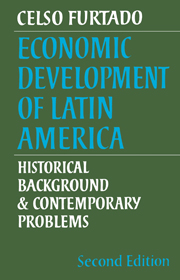Book contents
- Frontmatter
- Contents
- Tables
- Preface to the second edition
- Preface to the first edition
- Abbreviations
- Maps
- PART ONE FROM THE CONQUEST TO THE FORMATION OF NATION-STATES
- PART TWO ENTRY INTO THE SYSTEM OF INTERNATIONAL DIVISION OF LABOUR
- PART THREE THE TRADITIONAL STRUCTURAL PATTERN
- PART FOUR CHARACTERISTICS OF THE INDUSTRIALISATION PROCESS
- PART FIVE REORIENTATION OF DEVELOPMENT IN THE RECENT PERIOD
- PART SIX INTERNATIONAL RELATIONS
- PART SEVEN INTRA-REGIONAL RELATIONS
- 20 Integration process in Central America
- 21 LAFTA and the Andean Group
- PART EIGHT STRUCTURAL RECONSTRUCTION POLICIES
- Bibliography
- Index
21 - LAFTA and the Andean Group
Published online by Cambridge University Press: 25 January 2010
- Frontmatter
- Contents
- Tables
- Preface to the second edition
- Preface to the first edition
- Abbreviations
- Maps
- PART ONE FROM THE CONQUEST TO THE FORMATION OF NATION-STATES
- PART TWO ENTRY INTO THE SYSTEM OF INTERNATIONAL DIVISION OF LABOUR
- PART THREE THE TRADITIONAL STRUCTURAL PATTERN
- PART FOUR CHARACTERISTICS OF THE INDUSTRIALISATION PROCESS
- PART FIVE REORIENTATION OF DEVELOPMENT IN THE RECENT PERIOD
- PART SIX INTERNATIONAL RELATIONS
- PART SEVEN INTRA-REGIONAL RELATIONS
- 20 Integration process in Central America
- 21 LAFTA and the Andean Group
- PART EIGHT STRUCTURAL RECONSTRUCTION POLICIES
- Bibliography
- Index
Summary
Montevideo treaty and its operation
The four southernmost Latin American countries - Argentina, Brazil, Chile and Uruguay - had traditionally carried on a relatively important reciprocal trade in primary products. The bulk of this trade was between Argentina and Brazil, consisting on the part of Argentina mainly of wheat, and on the part of Brazil of tropical products - coffee and cocoa - and timber, an exchange which generally resulted in an adverse balance for Brazil. During the Second World War, difficulties in securingexternal supplies boosted intra-regional trade. Argentina increased her imports from Brazil and stepped up her trade with other Latin American countries. After 1945, balance of payments difficulties led to an intensification of bilateralism, within the framework of which trade among the southern countries mentioned could continue to develop. In 1950, exchanges between these four countries accounted for 9.2 per cent of their total foreign trade and in 1953 for 12.2 per cent. From the mid-1950s, however, the effort made, under pressure from the International Monetary Fund, to promote trade liberalisation and extend tariff preferences on a multilateral basis, initially in Argentina and Chile and, later, in Brazil, led to a sharp decline in the reciprocal trade of these countries, a problem which caused increasing concern in the region. To some extent, bilateralism had performed the role of protectionism extended over a wider area and, given the characteristics of the national economies concerned, it could reasonably be held that its disappearance would entail a fall in the level of activity.
- Type
- Chapter
- Information
- Economic Development of Latin AmericaHistorical Background and Contemporary Problems, pp. 232 - 241Publisher: Cambridge University PressPrint publication year: 1977



